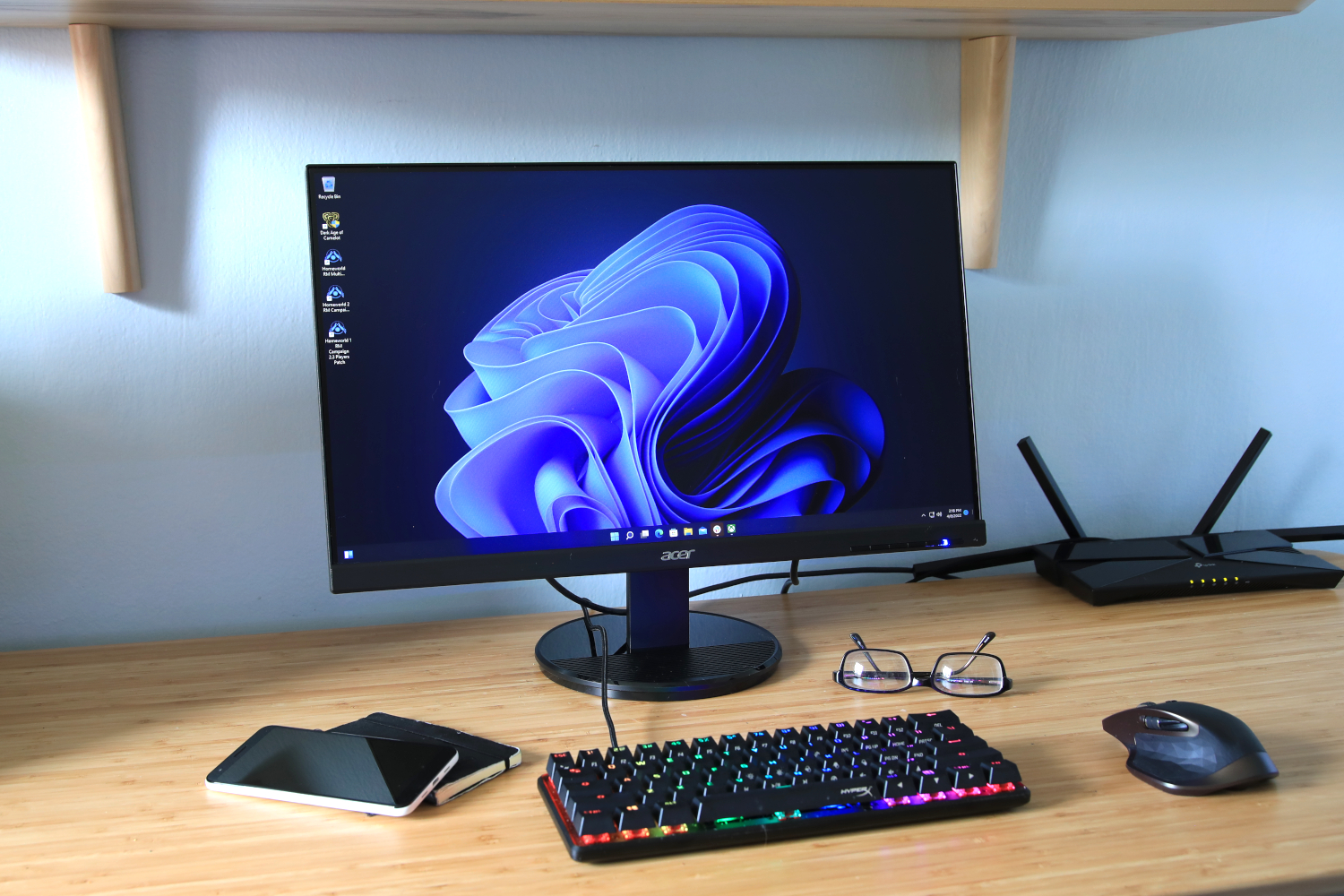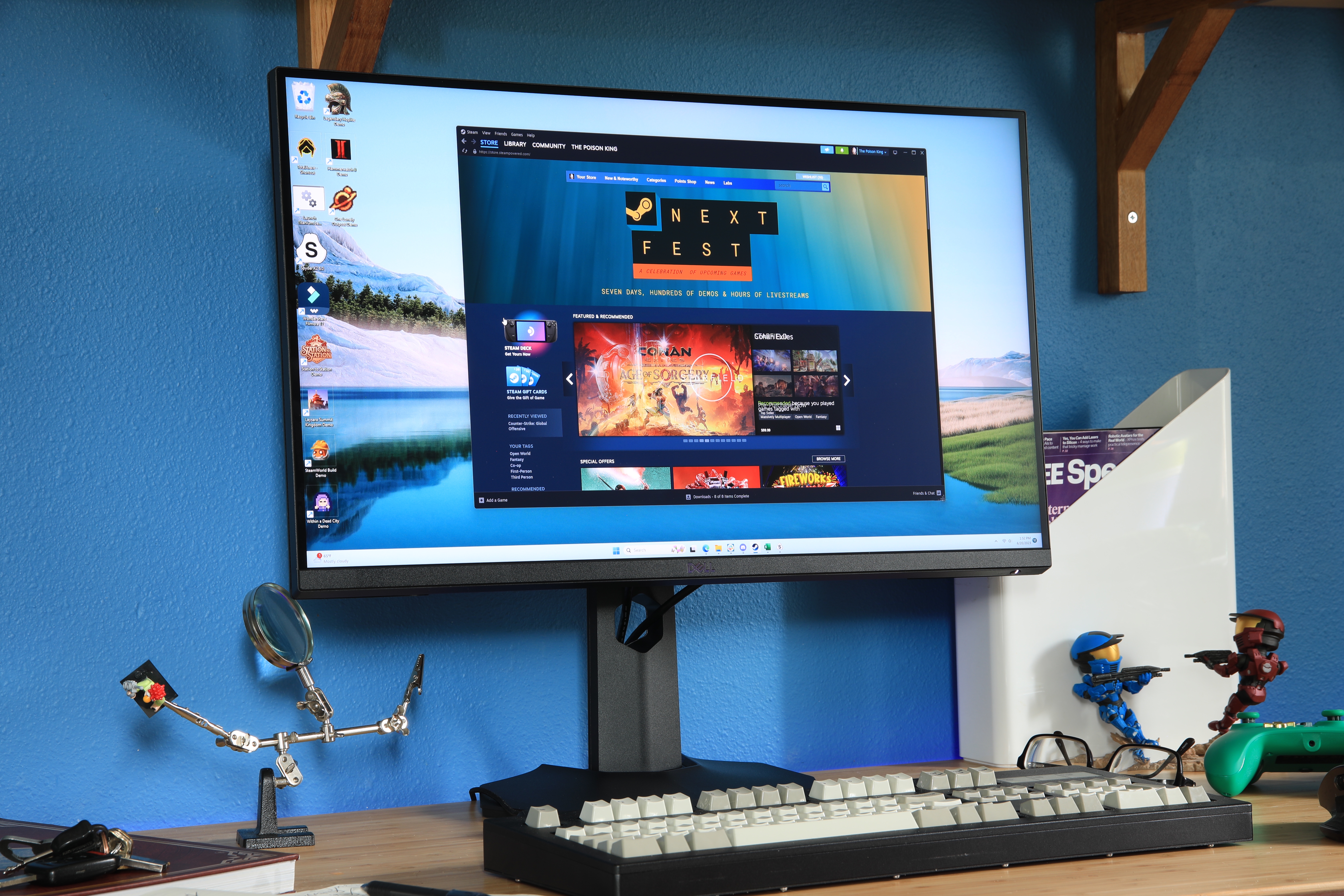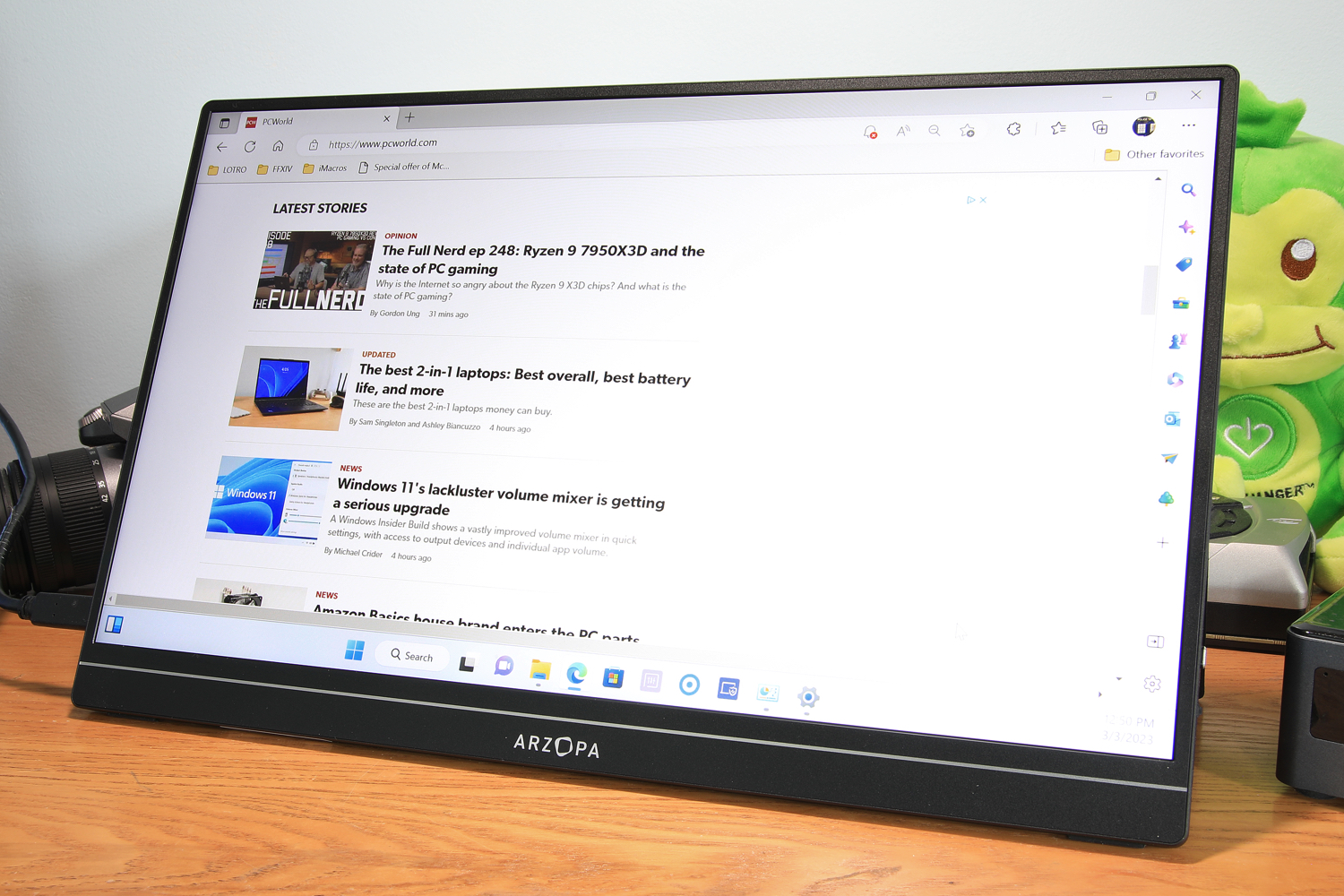Best budget monitors: Screens that save you money


The best modern monitors deliver stunning image quality, but pricing can quickly skyrocket above $500 and, in some cases, beyond $1,000. That’s a lot of money to spend on a 24-inch to 32-inch display.
Fortunately, shoppers on a more reasonable budget can find numerous options available for around $200 (or less). These affordable monitors can’t match those that sell for five times the price, but the best budget monitors offer surprisingly great image quality that might leave you wondering why anyone would pay more.
Further reading: See our roundup of the best monitors for even more recommendations.
Updated 07/18/2023: To include the Dell G2724D as our new choice for best budget gaming monitor. Read our summary below for more info on this inexpensive new pick with a ton of great gaming-centric features.
Acer K242HYL – Best budget monitor overall

Pros
Attractive color accuracy and gamut Acceptable sharpness for a 1080p display Avoids motion clarity pitfalls Menu system is easy to use
Cons
Barebones design No height adjustment on stand Only one HDMI, no DisplayPort Power LED is very bright Price When Reviewed:$149Best Prices Today:$149.99 at Acer
The Acer K242HYL is a reliable and attractive budget monitor that will fit the needs of most shoppers looking to buy a monitor for around $150.
It’s a 24-inch, 1080p monitor with a refresh rate of up to 75Hz. The monitor’s specifications are identical to alternatives near the same price, but the K242HYL’s overall image quality is a notch above the pack. It provides a sharp, bright image with attractive and accurate color.
The monitor’s 75Hz refresh rate is slightly smoother than the more typical refresh rate of 60Hz. Acer even throws in AMD FreeSync support, which can be used to sync the refresh rate with a connected AMD graphics solution. This will reduce stutter and screen tearing in 3D games.
Acer opts for a simple stand that only adjusts for tilt, which is typical for a budget monitor. The stand is reasonably tall and keeps the monitor planted on your desk. A 100x100mm VESA mount is included and can be used to attach a third-party monitor stand or arm if desired.
The monitor’s design and build quality is excellent for the price. Our only serious complaint concerns connectivity, as the monitor has just one HDMI and one VGA. We’d prefer to see a second HDMI port or DisplayPort, as well.
Still, shoppers looking for a simple, no-fuss option should stop looking and buy the K242HYL. It won’t disappoint.
Read our full Acer K242HYL review
Dell G2724D – Best budget gaming monitor

Pros
Handsome design with functional stand Attractive SDR image quality Good motion clarity at 165Hz Supports all Adaptive Sync standards
Cons
No USB connectivity or 3.5mm audio-out Lackluster HDR Price When Reviewed:$299.99Best Prices Today:$199.99 at Dell Home$224.99 at Dell
The Dell G2724D is an excellent choice for those on a budget but who don’t want to compromise on quality. It has an attractive design, strong motion clarity at 165Hz, and broad Adaptive Sync support, all of which help to provide an immersive gaming experience at an affordable price.
The 27-inch IPS LCD panel has a resolution of 1440p and a refresh rate of 165Hz. Additionally, the color gamut spans 100 percent of sRGB, 86 percent of DCI-P3, and 82 percent of Adobe RGB, so you can expect to get a bright and vibrant image that’s excellent in games and adequate for most content creation. All of this is reason enough to like this monitor, but its Adaptive Sync support is actually its standout feature, with official support for VESA Adaptive Sync, AMD FreeSync Premium, and Nvidia G-Sync.
It also delivers an attractive design with a matte black and gray chassis and sporty rear vents that provide an aggressive yet unobtrusive look. It also comes with a functional monitor stand that offers a range of ergonomic adjustments and a compact base that doesn’t take up unnecessary desktop space.
There are a few downsides to note. The monitor doesn’t offer USB connectivity or 3.5mm audio-out. Also, the HDR performance is a bit lackluster, so those who require HDR gaming may want to look at other options.
Yet it’s hard to beat the G2724D’s performance at $300 or below and, more importantly, it offers everything an average PC gamer is going to need for smooth, responsive, and attractive gaming experience. It’s an excellent monitor that, despite its budget price, could have a place on your desk for five to 10 years.
Read our full Dell G2724D review
Arzopa A1 Gamut – Best budget portable monitor

Pros
Good build quality for the price Bright, attractive display Two USB-C inputs, plus mini-HDMI All cables included
Cons
Stand only adjusts for tilt Limited image quality adjustments Mediocre contrast ratio Price When Reviewed:$189.99Best Prices Today:$99.99 at Arzopa
The Arzopa A1 Gamut is a 15.6-inch 1080p portable monitor with attractive image quality, a svealt design, and practical features at an affordable price. The display’s profile is slim with a slight bulge on the lower half, where the ports and internal electronics live. An included faux-leather cover protects the display when stowed and serves as a kickstand when in use.
Our testing found the A1 Gamut can deliver up to 297 nits of brightness, which is superb for a budget portable monitor. The monitor also has an attractive color gamut and good color accuracy. Contrast is a bit lacking, but no more so than other budget portable monitors. Sharpness is a highlight, as 1080p resolution looks crisp when packed into a 15.6-inch panel.
The monitor has two USB-C ports with DisplayPort Alternate Mode and one Mini-HDMI port, for a total of three video inputs. Both USB-C ports support Power Delivery and can power the portable monitor from a connected USB-C device or a USB-C power brick. All necessary cables and accessories are included.
The Arzopa A1 Gamut’s official MSRP hovers around $170, but it’s frequently found on sale for as little as $110. We highly recommend waiting for a price drop if it’s not currently on sale. Additionally, if you like the Arzopa A1 Gamut, but you aim to use a portable monitor for gaming, you may want to check out the Arzopa G1 Game display. For just a bit more money you get game-centric upgrades such as a 144Hz refresh rate and HDR compatibility.
Read our full Arzopa A1 Gamut review
What to look for in a budget monitor
Budget monitors typically involve some sacrifice—costs are cut from somewhere, after all—so you want to know what features matter most for the money.
Image quality
Budget monitors have a reputation for lackluster image quality. Recent models buck that trend. While some sub-par budget models remain on the market, all the monitors we recommend in this guide nail the fundamentals. They offer a bright, vivid, and colorful image that’s enjoyable and comfortable to view even in a brightly lit room.
Resolution
Nearly all budget monitors provide a native resolution of 1920×1080, also known as 1080p. You may find 1440p or 4K monitors available at similar pricing, but they often sacrifice other aspects of image quality. 1080p is popular for a reason: It’s attractive, versatile, and good value for money.
Refresh rate and adaptive sync
Most budget monitors have a refresh rate of 60Hz to 75Hz. Only gaming monitors reach a higher refresh rate, and gamers are the only group that needs to pay attention to this specification. Gamers will want to aim for 144Hz or better. Everyone else will be happy with a 60Hz display.
Adaptive Sync is a related feature that can sync the output of a graphics solution or video card with the monitor. This eliminates screen tear and micro-stuttering. It’s a must-have feature for gamers and can be ignored by everyone else.
Connectivity
Budget monitors have simple connectivity with just a handful of video inputs. You’ll want to purchase a monitor that has a video input compatible with your laptop or desktop’s video output. Most computers support HDMI, but a few desktops and laptops only support DisplayPort. PCs that are more than 10 years old may only support VGA and DVI, and some budget monitors still support these options. Our top pick, the Acer K242HYL, supports HDMI and VGA.
Stand and ergonomics
Inexpensive monitors usually skimp on ergonomics and offer a simple, integrated stand that only adjusts for tilt. That’s fine for web surfing and general productivity, but a height adjustable stand will be preferable if you want a monitor for your home office or plan to use multiple monitors side-by-side.
At the least, a budget monitor should provide a 100x100mm VESA mount. This standard mount size can be used with a huge variety of third-party stands and arms—the options are nearly endless. Portable monitors are the exception and rarely include support for a VESA mount.
How we test monitors
PCWorld’s monitor buying guides are based on the knowledge and skills of our freelance and staff contributors, who together possess decades of experience in the field.
While we rely on our personal impressions to guide coverage, we also thoroughly test each monitor with a SpyderXElite color calibration tool for an in-depth analysis. This tool lets us objectively evaluate various monitor attributes, such as brightness, contrast, color gamut, color accuracy, luminance and color uniformity, gamma, and more.
Every monitor we recommend in this guide was thoroughly reviewed with personal, hands-on testing by a PCWorld contributor. This helps us identify problems in features and build quality that could otherwise be overlooked.
FAQ
1.
What’s the best size for a budget monitor?
Most budget monitors have a 24.5-inch or 27-inch display panel. The difference between them is exactly what you’d expect: the size. A 24.5-inch display is more compact and easier to fit on a desk, while a 27-inch display is larger and more immersive.
With that said, the difference between a 24.5-inch and 27-inch display is minor. A 27-inch monitor will be slightly more than two inches wider and one inch taller than a 24.5-inch model. You can make a 24.5-inch display look like a 27-inch display by sliding it a few inches closer to you.
What about 32-inch monitors? They’re much larger than a 27-inch display and may not fit well on smaller desks. The larger display size tends to come with a higher price tag, which is why we don’t recommend a 32-inch budget monitor.
2.
What resolution is best for a budget monitor?
Budget monitors almost always provide a native resolution of 1920×1080, better known as 1080p. This resolution is a good fit for a 24.5-inch to 27-inch display. A higher resolution is preferable, especially on a 27-inch display, but bumping the resolution to 1440p or 4K bumps the price just outside of budget territory.
Avoid budget monitors with 720p, or 1366×768 resolution. These are rare in 2023 but do appear on Amazon and other online retailers from time to time. This resolution is far too low for viewing modern content, leading to a blocky, pixelated look.
3.
What ports and connectivity should a budget monitor have?
Budget monitors rarely offer a wide variety of ports, and most users don’t need anything beyond the basics. You can expect a typical budget monitor to offer one HDMI and one DisplayPort input. Anything beyond that is a bonus.
Some budget monitors, like the Acer K242HYL, have a VGA port. Though increasingly rare, shoppers in the budget category are more likely to hang on to an old PC with a VGA output and may appreciate its inclusion.
4.
Does a budget monitor need a high refresh rate display?
Most budget monitors don’t need a high refresh rate. A refresh rate of 60Hz to 75Hz is adequate for day-to-day use.
Gamers are the exception, as modern games can benefit from the improved clarity and smooth motion of a high refresh rate. We recommend that gamers look for a refresh rate of at least 144Hz. Numerous budget monitors clear this bar. Our favorite budget gaming monitor, the Dell G2723H, ups that ante with a tremendous 280Hz refresh rate.
5.
Does a budget monitor need HDR?
No, a budget monitor doesn’t need HDR. While we have tested budget monitors that support HDR, we’ve yet to test one that delivers a level of brightness and overall image quality suitable for HDR content. Budget monitors that support HDR can display an HDR signal, but you may have trouble noticing an improvement over SDR. In some cases, HDR may even look worse than SDR. We hope this situation will change soon. For now, however, leave HDR out of your budget monitor wish list. Computer monitors that can handle HDR, like the AOC Agon Pro AG274QZM, start around $600, and the best HDR monitors exceed $1,000.
Author: Matthew S. Smith
Matthew S. Smith is a freelance technology journalist with 15 years of experience reviewing consumer electronics. In addition to PCWorld, his work can be found on Wired, Ars Technica, Digital Trends, Reviewed, IGN, and Lifewire. Matthew also covers AI and the metaverse for IEEE Spectrum and runs Computer Gaming Yesterday, a YouTube channel devoted to PC gaming history.
Recent stories by Matthew S. Smith:
Best monitor arms 2024: The ultimate in flexibilityPixio PX248 Wave review: A monitor for fashion, flair, and clarity on a budgetBest portable monitors 2024: Displays that go with you







